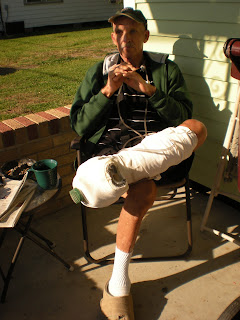4:10 AM- A shotgun shack on West B Street, Norco, LA. In the neighbor’s back yard, a rooster cries plaintively into the foggy darkness. “Little rooster crowing, he must have something on his mind”. A mile to the north a freight train howls its sad lament. On Highway 61, sirens swirl their shrill cacophony. A mile to the east, the stacks of the mammoth refineries spew noxious noise and smoke and flame. Two blocks to the south, over the banks of the levee, huge freighters and barges and tugs and tankers plow through the roiling waters of the muddy Mississippi. The pre-dawn hours are a special time, half dream, half memory, half cold clarity (do the math), full of fear and longing and regret and sensual memories. Next to me on his sick bed (well couch, really) lies Jan’s brother Gary who is struggling every moment in the advanced stages of diabetes. He has lost fingers and toes because of an inability to heal and fight infection. Most of his left foot has been an open, festering wound for at least a year now. He has lost his wife, his home, his business, his vision, his dogs, and is partly estranged from his kids. “When you think you’ve lost everything, you find out you can always lose a little more. I’m just going down the road feelin’ bad, Tryin’ to get to heaven before they close the door.” Imagine how you feel after three days of the flu. Now try to do that for a year or two. He’s still Gary though, and he’s hanging in, and we’re hangin’ with him.
In marked contrast to that scenario, Fairhope, Alabama lies midway down the east coast of Mobile Bay in an area of quaint splendor, ancient oaks, well-tended estates, waterfront homes, and a casually funky small town with an artsy-fartsy ambience. From Norco , we travel east through New Orleans, and then along the coast of the Gulf of Mexico past Pass Christian, Gulfport, Biloxi, and Pascagoula. Our boat is at a marina on Fly Creek (Devil’s Hole on the chart) which is surrounded by tall grasses, huge trees ,shrimp boats, the new yacht club across the creek, and a grassy park next to the bay looking west. Just down the road is the previous home of Ed "Stock" Stanky with a pentangle that says HOME PLATE. From our foredeck, we watch the sun set and look for the green flash most nights at five o’clock “Down around Biloxi…..off towards new Orleans”. We are back and forth from Norco, so we’ve been getting some work done on the boat (i.e. painting the cabin sides etc.) and have had a couple of really fine sails in the prevailing southeasterlies. Haven’t really gotten that fishing thing going yet, but I’m working on it, Rog. 30 miles to the south of Fairhope lies the white sand beaches of Gulf Shores, Orange Beach, Perdido Key, etc. We spent a few nights down there at the Florabama and Pirate’s Cove taking in the Frank Brown Memorial Songwriter’s Festival some highlights of which were Billy Joe Shaver, Sonny Throckmorton, Wild Bill Emerson, and the full moon over a wild windy Gulf beach at 1 am. Well, the kids gotta have a little fun, to yet a minute. We’re going to try to make the west coast of Florida for Christmas. Hope you all are safe and well. Dave and Jan
 |
| view from the fo'c'sle |
 |
| bottom feeders feeders suppliers |
 |
| G to the G |
 |
| local color |
Eddie Stanky
From Wikipedia, the free encyclopedia
| Eddie Stanky | |
|---|---|
Stanky as player-manager of the Cardinals. | |
| Second baseman / Manager | |
| Born: September 3, 1916 Philadelphia, Pennsylvania | |
| Died: June 16, 1999 (aged 82) Fairhope, Alabama | |
| Batted: Right | Threw: Right |
| MLB debut | |
| April 21, 1943 for the Chicago Cubs | |
| Last MLB appearance | |
| July 25, 1953 for the St. Louis Cardinals | |
| Career statistics | |
| Batting average | .268 |
| Hits | 1,154 |
| Runs batted in | 364 |
| Teams | |
As player
| |
| Career highlights and awards | |
Contents |